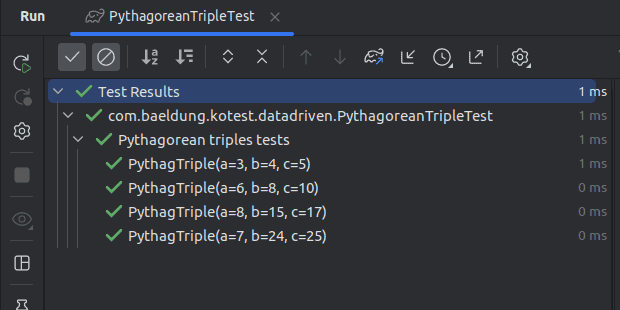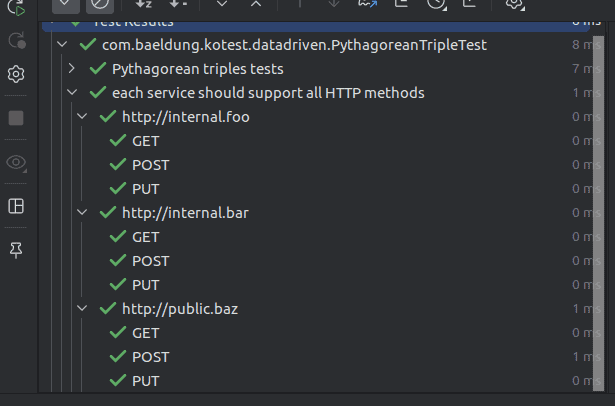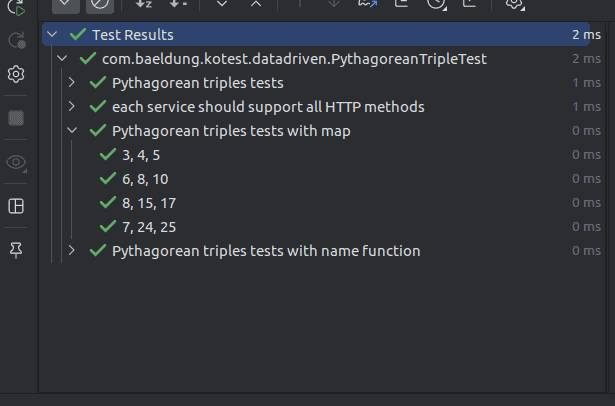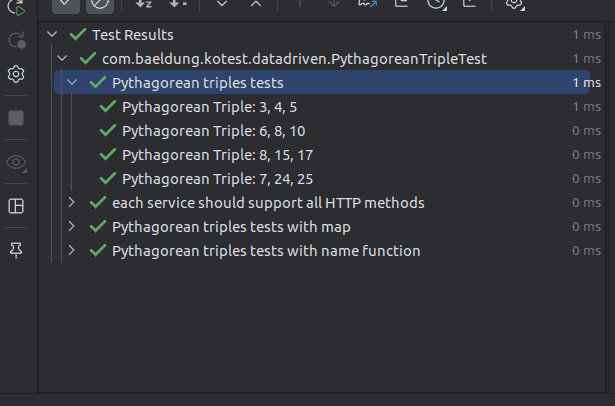1. 简介
数据驱动测试(Data-Driven Testing),也称为表格驱动测试,是一种强大的测试技术,用于验证多种输入组合对某个函数的行为是否符合预期。它特别适用于需要测试大量输入组合的场景,确保代码在各种情况下都能正常运行。
Kotest 是一个灵活且功能全面的 Kotlin 测试框架,它对数据驱动测试提供了原生支持,使得编写覆盖广泛输入组合的测试变得简单高效。
在本文中,我们将探讨如何利用 Kotest 的数据驱动测试功能来构建健壮且全面的测试用例。内容包括基础示例、嵌套数据测试、自定义测试名称等,同时也会说明数据驱动测试在测试套件中的优势。
2. 基础示例:判断勾股数
我们以一个常见的数学问题为例:判断一组三个整数是否构成勾股数(Pythagorean Triple)。勾股数是指满足 a² + b² = c² 的正整数三元组 *(a, b, c)*。
我们先定义一个函数 isPythagTriple() 来判断:
fun isPythagTriple(a: Int, b: Int, c: Int): Boolean {
if (a <= 0 || b <= 0 || c <= 0) return false
return a * a + b * b == c * c
}
接下来,我们使用 Kotest 进行数据驱动测试。首先定义一个数据类来表示一行测试数据:
data class PythagTriple(val a: Int, val b: Int, val c: Int)
然后编写测试类,使用 withData() 方法进行多组数据测试:
class PythagoreanTripleTest : FunSpec({
context("Pythagorean triples tests") {
withData(
PythagTriple(3, 4, 5),
PythagTriple(6, 8, 10),
PythagTriple(8, 15, 17),
PythagTriple(7, 24, 25)
) { (a, b, c) ->
isPythagTriple(a, b, c) shouldBe true
}
}
})
✅ 每个 withData 中的参数都会生成一个独立的测试用例
✅ 若某组数据测试失败,Kotest 会明确指出失败的输入组合

3. 嵌套数据测试
Kotest 支持嵌套数据测试,这在测试多个维度组合时非常有用。例如,我们可以测试多个服务对不同 HTTP 方法的响应:
context("each service should support all HTTP methods") {
val services = listOf(
"http://internal.foo",
"http://internal.bar",
"http://public.baz"
)
val methods = listOf("GET", "POST", "PUT")
withData(services) { service ->
withData(methods) { method ->
// test service against method
}
}
}
⚠️ 该测试会生成 services 和 methods 的笛卡尔积,即每个服务都测试所有方法

4. 自定义测试名称
默认情况下,Kotest 会使用数据类的 toString() 方法生成测试名称。但我们可以通过多种方式自定义测试名称,使结果更清晰易读。
4.1. 稳定名称支持
Kotest 会判断数据类是否具有“稳定”的 toString(),否则会使用类名作为测试名。我们可以使用 @IsStableType 注解显式声明其稳定性:
@IsStableType
data class PythagTriple(val a: Int, val b: Int, val c: Int)
4.2. 使用 Map 显式指定名称
通过将数据和名称封装为 Map,可以显式指定每组数据的测试名:
context("Pythagorean triples tests with map") {
withData(
mapOf(
"3, 4, 5" to PythagTriple(3, 4, 5),
"6, 8, 10" to PythagTriple(6, 8, 10),
"8, 15, 17" to PythagTriple(8, 15, 17),
"7, 24, 25" to PythagTriple(7, 24, 25)
)
) { (a, b, c) ->
isPythagTriple(a, b, c) shouldBe true
}
}

4.3. 使用函数动态生成名称
我们也可以通过提供一个函数来动态生成测试名称:
context("Pythagorean triples tests with name function") {
withData(
nameFn = { "${it.a}__${it.b}__${it.c}" },
PythagTriple(3, 4, 5),
PythagTriple(6, 8, 10),
PythagTriple(8, 15, 17),
PythagTriple(7, 24, 25)
) { (a, b, c) ->
isPythagTriple(a, b, c) shouldBe true
}
}

4.4. 实现 WithDataTestName 接口
我们还可以让数据类实现 WithDataTestName 接口,由接口方法提供名称:
data class PythagTriple(val a: Int, val b: Int, val c: Int) : WithDataTestName {
override fun dataTestName() = "Pythagorean Triple: $a, $b, $c"
}

5. 小结
数据驱动测试是一种非常有效的测试方法,尤其适用于需要验证多种输入组合的场景。Kotest 对其提供了原生支持,极大地简化了测试用例的编写和维护。
✅ 数据驱动测试能提高测试覆盖率
✅ 支持嵌套数据组合,适合多维测试场景
✅ 提供多种方式自定义测试名称,增强可读性
✅ 避免重复代码,提高测试效率
通过本文的介绍,你应该已经掌握了在 Kotest 中使用数据驱动测试的基本技巧。在实际项目中,合理使用这一技术,可以显著提升测试质量和开发效率。